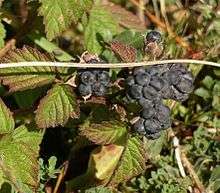Rubus caesius
Rubus caesius is a Eurasian species of dewberry, known as the European dewberry.[3] Like other dewberries, it is a species of flowering plant in the rose family, related to the blackberry. It is widely distributed across much of Europe and Asia from Ireland and Portugal as far east as Xinjiang Province in western China.[4] It has also become sparingly naturalized in scattered locations in Argentina, Canada, and the United States.[5][6][7][8]
| Rubus caesius | |
|---|---|
 | |
| 1885 illustration[1] | |
| Scientific classification | |
| Kingdom: | Plantae |
| Clade: | Tracheophytes |
| Clade: | Angiosperms |
| Clade: | Eudicots |
| Clade: | Rosids |
| Order: | Rosales |
| Family: | Rosaceae |
| Genus: | Rubus |
| Species: | R. caesius |
| Binomial name | |
| Rubus caesius | |
| Synonyms[2] | |
| |
Description

Rubus caesius is similar to and often confused with forms of Rubus fruticosus.[4] It is a small shrub growing up to 2 m (6 ft 7 in) tall with biennial stems which die after fruiting in their second year. It sends out long runners which root at the tip to form new plants. The stems are bluish-grey and sometimes prickly. The alternate leaves are hairy above and below. They are stalked and the leaf blades are palmate in shape, either consisting of three oval leaflets with serrated margins and acute points or just being three-lobed. The inflorescence is a loose cluster of several white flowers about 2.5 cm (1 in) in diameter. The calyx has five sepals and the corolla is composed of five spreading petals with finely toothed margins. There is a boss of stamens in the centre and there are several pistils. The fruit is an aggregate of several black, fleshy drupes with a bluish waxy bloom. The dewberry flowers from June to September.[9][7]
Distribution and habitat
Rubus caesius most often inhabits areas with rocky, basic soil and light shade.[4] It is often found in forest margins, coppices, rocky broadleaf woods and waterside thickets.[10] The Dewberry can hybridise with the raspberry (Rubus idaeus) and the stone bramble (Rubus saxatilis).

Hybrids
Various hybrids and cultivars have been developed from the wild form of R. caesius, including 'Youngberry' (a raspberries, blackberries, and dewberries hybrid),[11] olallie blackberry and marionberry.
References
- illustration from Prof. Dr. Otto Wilhelm Thomé, Flora von Deutschland, Österreich und der Schweiz 1885, Gera, Germany
- The Plant List, Rubus caesius L.
- "Rubus caesius". Natural Resources Conservation Service PLANTS Database. USDA. Retrieved 24 October 2015.
- "Rubus caesius (Dewberry)". Online Atlas of the British & Irish Flora. Biological Records Centre. Retrieved 9 August 2013.
- "PLANTS profile for Rubus caesius (European dewberry)". USDA. Retrieved 9 August 2013.
- Flora of China, Rubus caesius Linnaeus, 1753. 欧洲木莓 ou zhou mu mei
- Flora of North America, Rubus caesius Linnaeus, Sp. Pl. 1: 493. 1753. European dewberry
- Altervista Flora Italiana, Rubus caesius L. includes photos and European distribution map
- "Dewberry: Rubus caesius". NatureGate. Retrieved 29 December 2013.
- "Occurrence of European Dewberry, Rubus caesius (Rosaceae), Naturalized in Iowa and Michigan". Michigan Botanist. Retrieved 9 August 2013.
- Darrow, G.M. (1955). "Blackberry—raspberry hybrids". Journal of Heredity. 46 (2): 67–71.